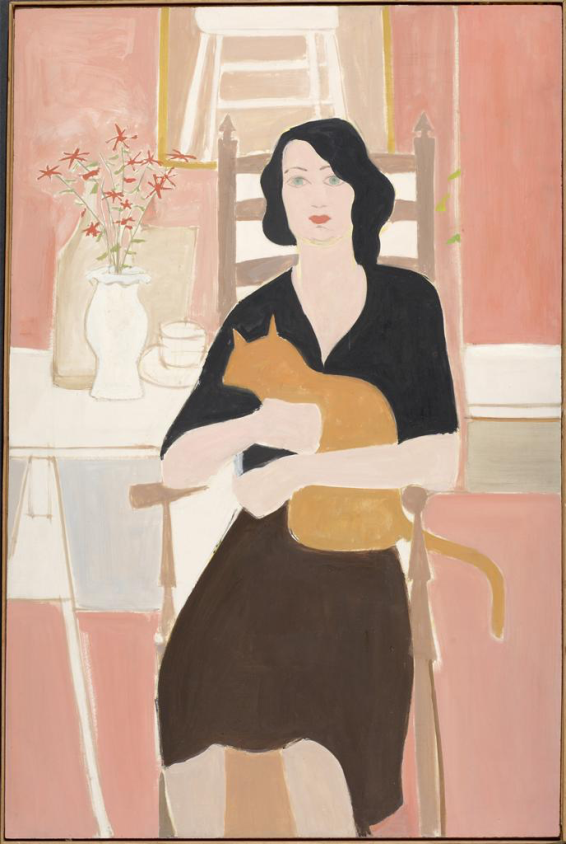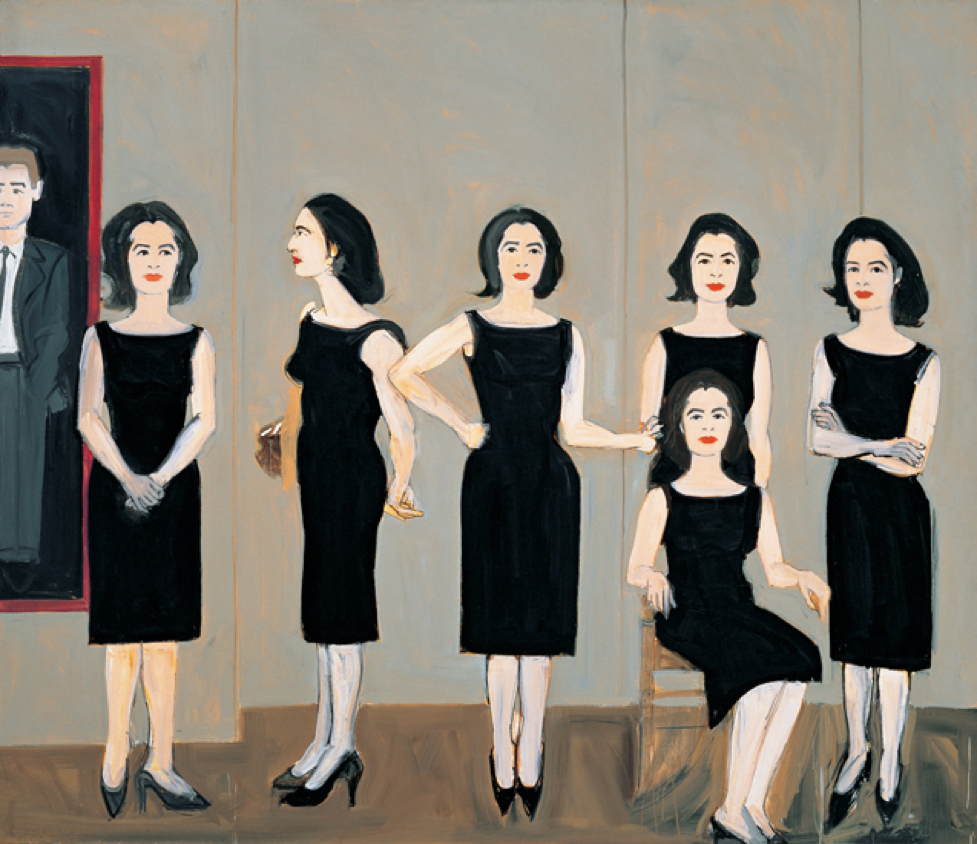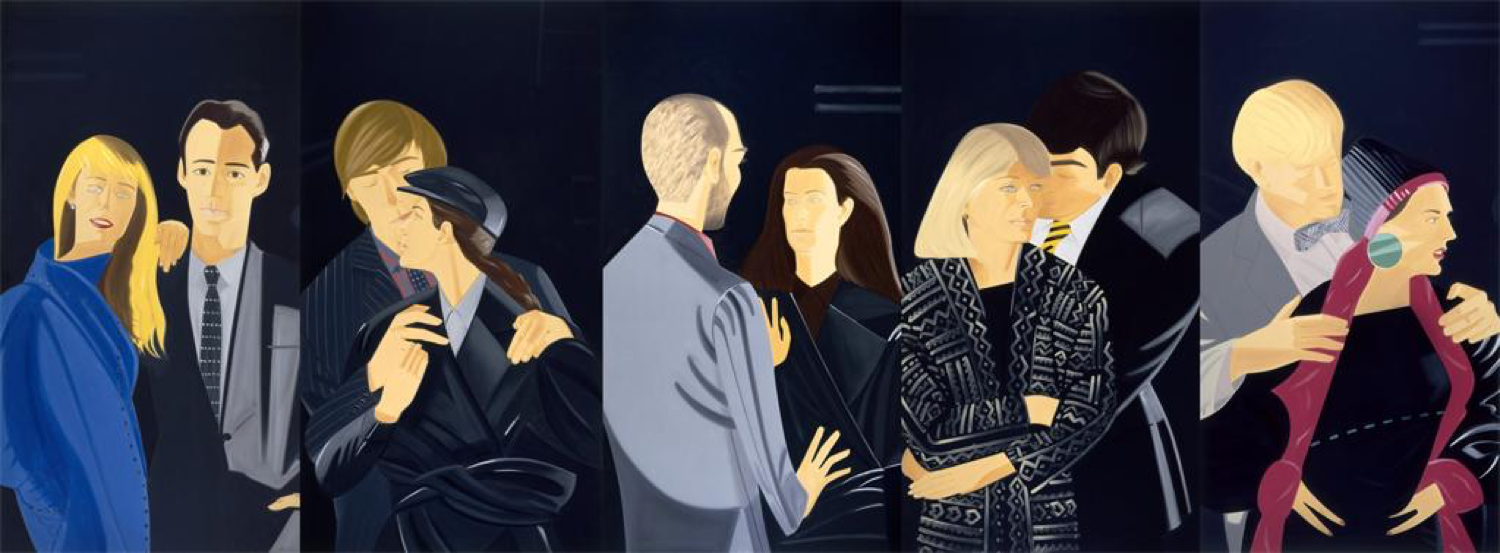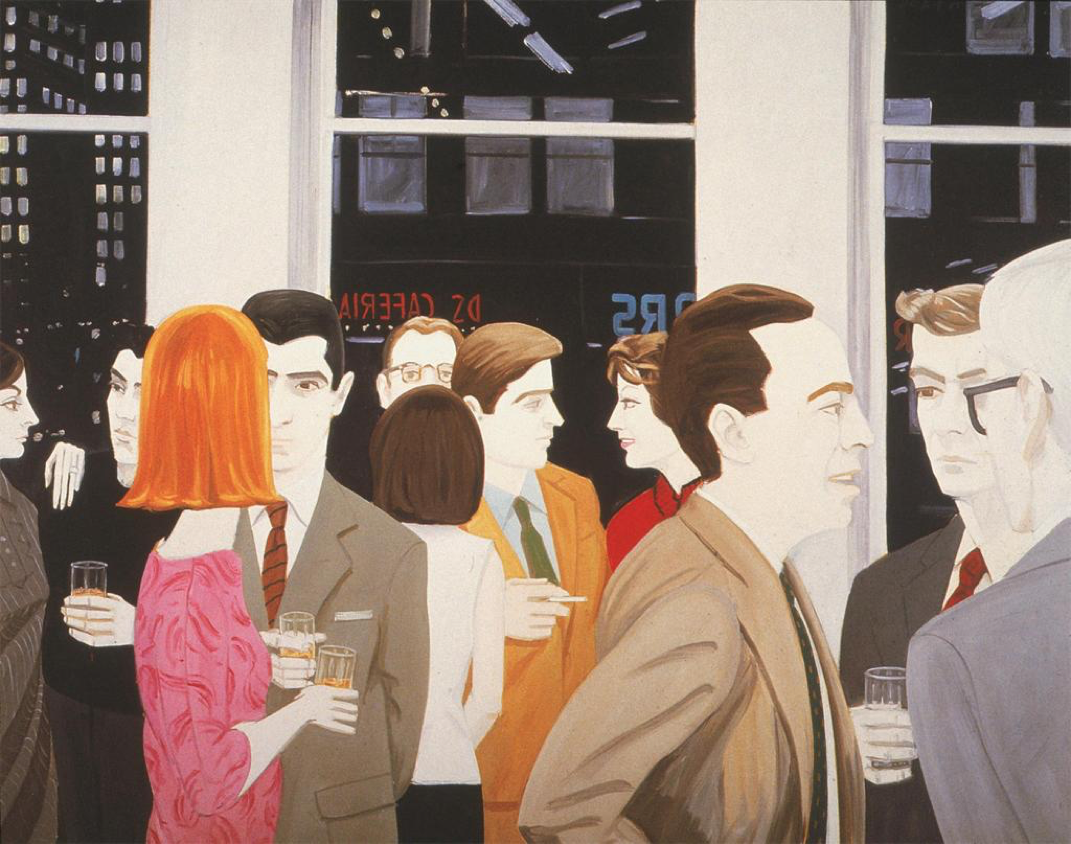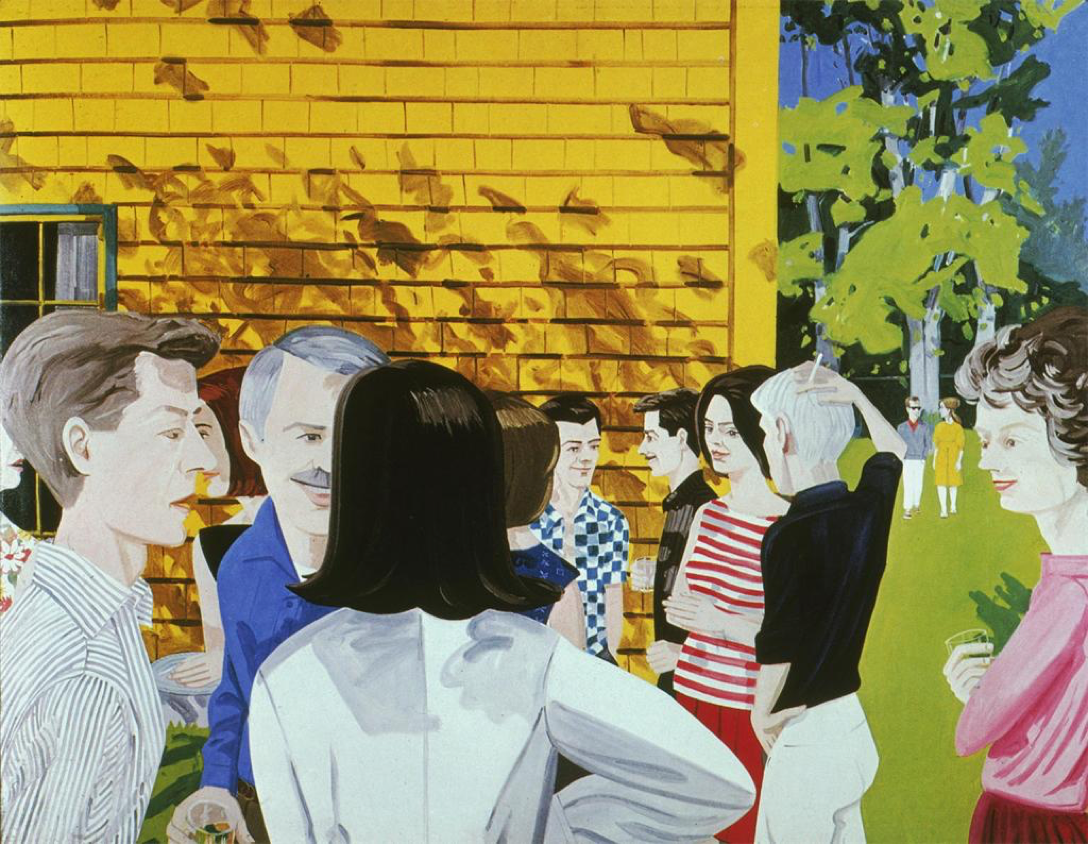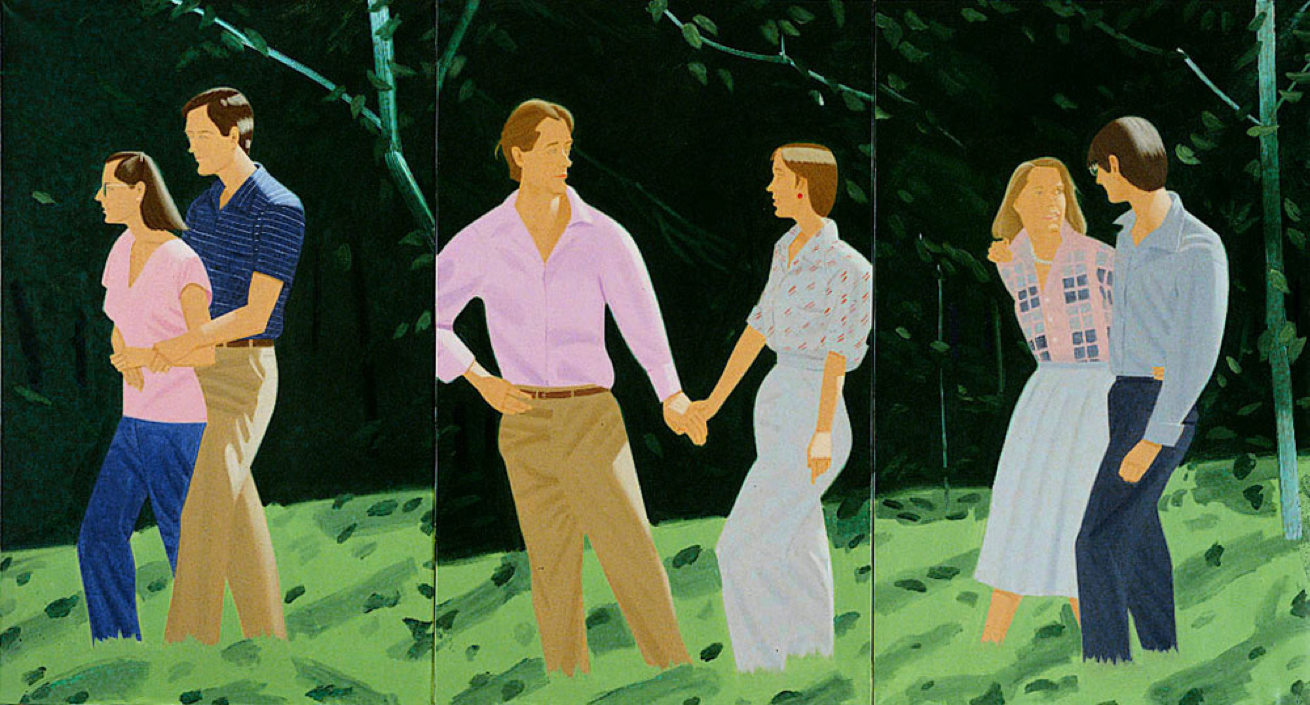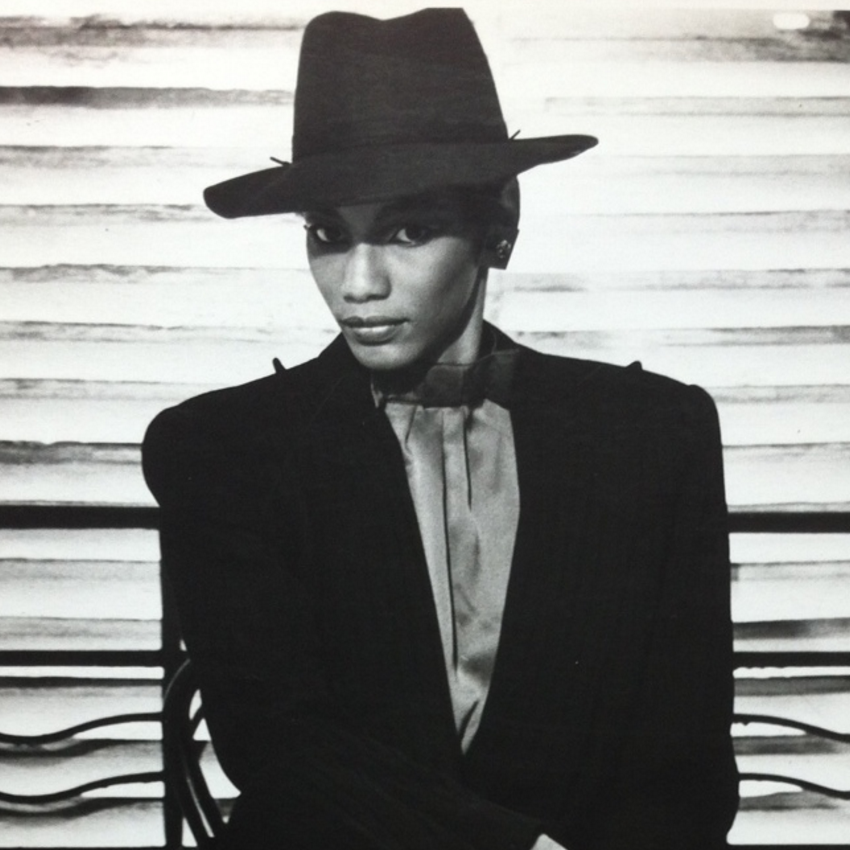Alex Katz and American Fashion
Because you live in the city where there is a value on elegance and beauty and that’s like one of the things I’m involved with. [1]
“Alex…grew up in a household where questions of style – in literature, in art, in clothes – were matters of vigorous discussion.” [2]
Painter Alex Katz is so closely attuned to the fashion scene – specifically the New York fashion scene – that it could be said that he has at times created or at least anticipated major shifts in it. Even his “sweet, unassuming” paintings set in bucolic Maine have a predictive quality to them. [3] Indeed, Katz and fashion form a kind of symbiosis.
His large, realistic paintings have drawn from American fashion since the 1950s. During this time, Katz has consistently chronicled and celebrated the exuberance and energy of American fashion from the critical postwar years to the present. His flair for capturing the essence of what is fashionable and chic – Particularly in New York City – is one of the core identifiers of his work, and iconic images such as The Black Dress, Pas De Deux, and the windows at Barneys New York qualify him as possibly the most important painter of fashion of the last sixty years. Yet it is also his “deliberately unflashy” works, particularly the ones in Maine such as Round Hill and Summer Triptych, that are just as vital and inspirational and that help drive not only his connection with fashion but also chronicle and define a distinctly American look. [4]
Early Works and Bohemian Rejection of Mainstream
“You feel a little disenfranchised as a person.…[E]verything was pretty precarious.” [5]
Katz, a World War II veteran, studied painting at the prestigious Cooper Union. He graduated in 1949 and stepped onto the art scene in New York at the exact time the city and its fashion proponents, such as Eleanor Lambert, sought to transform its garment industry into a design center that could rival Paris. Alex Katz, a realist painter who since childhood had an appreciation for fashion, was perfectly positioned in time and place to record what was happening in New York City during the critical post war era.
When I first approached the subject of Alex Katz and fashion, I mistakenly glossed over his early years in the downtown New York art scene of the 1950s. But these early works are critical to explaining his growth as a painter who is inextricably linked to the rise of American fashion. They show an authentic bohemian voice and foreshadow Katz’s vision of dress and style that is so closely aligned with the meteoric growth of American fashion.
Jean (1953)
Jean is the fashion precursor to Katz’s iconic Black Dress. Jean, the sitter and Katz’s first wife, wears a black monochrome V-neck top with a simple brown skirt. Missing is the defining 1950s silhouette: the wasp-waist, a look that originated in Paris with Christian Dior’s “Le Bar” suit. Jean’s natural, relaxed corset-free posture contrasts with the conformity of the Cold War era ideal of the fashionable woman. The look that Jean represents – casual, minimal and elegant – later became synonymous with American designers such as Halston, Calvin Klein and Donna Karan.
The New York Fashion Set and Understated Dandyism
“Because fashion is a wave, it catches a lot of different things.…[F]ashion has to do with clothes, with appearances, but other things connect with it at the same time.” [6]
By the 1960s, Alex Katz’s sitters appeared to have moved up socially, financially and professionally from Katz’s earlier “disheveled” subjects. In the 1960s, Irving Sandler, the art historian, saw the emergence of Alex Katz and his “world of a modern dandy.” Katz’s dandy is not one specific Beau Brummel but rather the “semiprivate world of New York’s avant-garde” showcased so effectively by Katz in his many group portraits. [7] Carter Ratcliffe is correct, Alex Katz is more than “the chronicler of a social milieu;” however, fashion documentation is a natural byproduct to Katz’s realistic paintings that often include clusters of people in the fashion capital of the United States – New York City. [8]
The Black Dress (1960)
In 1960, Katz reintroduces the subject of simple elegance that was hinted at in the earlier Jean in one of his most famous works, The Black Dress. [9] Here, his beautiful wife and favorite subject, Ada, appears repeatedly in the same chic, simple, understated black dress. Unlike Jean, Ada is no longer outside of the fashion conversation. She is now firmly in fashion. The dress is a symbolic meeting in the middle of the two worlds: mainstream fashionable society and the bohemian fringes. The painting was done the same year fashion icon Jackie Kennedy was photographed reading Jack Kerouac's The Dharma Bums. Bohemian concepts are no longer underground. Ada is not wearing a dress outside of societal norms but rather a sheath that would look just as fitting on the future first lady. [10]
One of the six Adas in the painting looks with a smirk at a man’s portrait on a gallery wall. It is a new decade and the artists have arrived. The Eisenhower era is over—Katz and his social set were no longer in a world hostile to their bohemian pursuits. [11] And with their new acceptance into high culture came acculturation by the establishment of the uniform of many downtown bohemian women – black – a look now so classic that even Katz revisited the subject of the black dress in later works. Calvin Klein wrote of one of Katz’s black dress paintings: “I…love what a simple black dress says about the woman who wears it.” He went on to say that the outfit is a “concise” choice that “ironically…has absolutely nothing to do with fashion.” [12] Klein is correct; however, one may disagree that the piece has nothing to do with fashion. Why else would Klein be so drawn to it? It is because Alex Katz distilled a sensibility in his work that fashion designers would and will inevitably find a continuous source of inspiration.
Pas De Deux (1983)
Pas De Deux is a large-scale painting that exists on a cinematic Hollywood level fitting of an American artist. The five beautiful heterosexual couples appear juxtaposed as in an editorial fashion magazine spread. Is there drama between the pairs? Or perhaps a narrative? No, they are just gorgeous people wearing fabulous clothes.
This painting, from a fashion-historical perspective, is an essential piece of American history. In this piece as well as the Eleuthera, Alex Katz used clothes by the American designer Norma Kamali. [13] Eleuthera is a very different piece from Pas De Deux, featuring a group of models in bathing suits; but it’s interesting that Katz used Kamali pieces more than once in his work and even mentioned it in his autobiography. Katz rebukes a contemporary art world that tends to disdain fashion as an art form. [14] Unlike the rest of his profession, Katz unashamedly supports fashion in his work and in his life. “I’d like it to be as fashionable as anything.” [15] Katz is so beyond cool that he can afford to nod at fashion designers in a way that many other artists are perhaps too scared to do.
Kamali, an American designer, was and continues to be known for taking fabrics such as knit jersey and draping them elegantly including evening attire. The partners in Pas De Deux are dressed for a night out but the clothing, as in Jean thirty years earlier, are loose fitting and probably comfortable. It isn’t just the clothes in the picture that are fashionable but the artist as well.
The Windows at Barneys New York (2015)
“The world has caught up with me,” said Katz. [16] His installation for the Barneys New York windows is proof. Alex Katz has already had a long and illustrious career as an artist. He could phone it in at this point and just revert back to his greatest hits but the black and white frieze for Barneys still has the feeling of being of the moment and yet with a fashion prescience. Katz has a great sense of the fashionable silhouette. Looking at these friezes makes one think about Anne Hollander, the fashion historian, and what she would say about our current fashionable body if she had seen the windows. Here is a painter who is not known for nudes yet understanding the fashionable physique always perfectly. The oversized exaggerated coats especially express this talent and where we are now.
The Cocktail Party (1965) and Lawn Party (1965)
Katz paints two worlds that feed on each other: the glittering, sophisticated trendy set of New York’s art-circuit elite and the relaxed, woodsy and nature-loving Maine – where he often paints close friends and family as well as luminous landscapes. [17]
In The Cocktail Party, one could imagine the same soiree taking place in a SoHo loft today – almost predicting gentrification of now one of the most expensive neighborhoods in America. The only thing that truly dates this cutting-edge piece are the men’s suits. Would many men still be wearing suits at a chic get-together? It’s the outdoor counterpoint of Lawn Party that predicts the casual dress of the future. Lawn Party feels like the same set of people but with a different backdrop—still just as fabulous, the conversation just as stimulating, but with a hint of how Americans would embrace and go beyond “dress-down Fridays.” Once again, Katz’s work predicts fashion trends. He is seeing things exactly as they are but also catches what will be hallmark looks for America in decades to come—casual attire, jersey knit tops, simple playful clothes that can be worn to SoHo loft party or to an idyllic Maine lawn party.
Maine and Anti-Fashion Leisure-wear
“Ada got some clothes of his [Isaac Mizrahi], and we both liked them a lot, because they were so American.” [18]
Impala (1968)
Sanford Schwartz wrote that for Katz, Maine is a place that fulfills the “occasional need to make things ‘ordinary’” and to create a sense of “deliberately unflashy idyll.” [19] In Katz’s work, Impala, from 1968, that “sweet, unassuming” quality that Schwarz refers to is present. The woman reminds me of Anna Wintour describing a young Tonne Goodman “a clean, minimal, gorgeous young woman who couldn’t be anything but an American girl.” [20] Alex Katz has said, “My style is completely American,” and the Chevy Impala moving forward with the pretty girl in the passenger seat attests to an all-American freshness. [21] Impala codifies a look that has remained a staple in women’s dressing for the last forty-eight years. That young woman’s outfit – striped boat neck knit top, pony tail, and simple jacket – would not have been out of place in 1978, 1988 or even today. It’s not an accident or coincidental. Nor do I believe it is an obvious statement. I think Alex Katz intuitively knew that even something so deceptively simple would always have an understated chicness to it.
Summer Triptych (1985)
Like Pas De Deux, Summer Triptych is a large-scale work that features glamourous female/male couples in some undetermined conversations that leave the viewer to feel that somehow their own world is just not quite as glamorous as the Katz world. Unlike Pas De Deux, the background is not a sophisticated New York inky black but the lush woods of Maine. Summer Triptych is the fashion fusion and culmination of his two homes. The couples are in khakis, jeans, pearls, and rolled up shirt sleeves. The country dressing melds with the city wardrobe. Or is it the other way around? The sitters could be wearing either Brooks Brothers or Ralph Lauren. One cannot tell. Did the couples hop on a bus directly from Manhattan to see their dear friend Alex Katz in Maine? If so, they didn’t need to change. His worlds have collided as he has all but predicted it would.
Conclusion
“For me, there’s nothing more mysterious than appearances.” [22]
Katz’s connection to the fashion world is well known and could legitimately fill an entire book dedicated to the subject: his paintings of supermodels, his portrait of Anna Wintour, his collaboration and admiration for designers and magazines such as Norma Kamali, Isaac Mizrahi, and W to his most recent window displays for Barneys and don’t even get me started on all the gorgeous iconic images of Ada. Katz has said that “art moves just like fashion…people think fine art is above fashion, and I think that’s ridiculous! …The fashion world is moving into the art world, and not the other way around.” [23]
Katz either always saw the coming of fashion as a legitimate art form or he helped bring it about by aligning it closely with his paintings. In his desire to paint things as they are in the present moment, he has been able to clearly see where society is stylistically headed. By painting the world around him – nothing more, nothing less – Katz visually articulated and predicted the essence of an American attitude in style: one built on a rebellious and free approach, casual and sporty, and like his painting style: minimal and clean but with a strong point of view.
Notes
[1] David Sylvester, Interviews with American Artists (New Haven: Yale University Press, 2001) 248.
[2] Carter Ratcliffe, Iwona Blazwick, and Storr Robert, Alex Katz (London, United Kingdom: Phaidon Press, 2005), 58.
[3] Sanford Schwartz, Alex Katz: Paints in Maine (Florence: Charta, 2005), 18.
[4] Schwartz, Maine, 15.
[5] Alex Katz, Invented Symbols: An Art Autobiography, ed. Vincent Katz (Italy: Charta/Colby Museum of Art, 2012), 77.
[6] Katz, Invented Symbols, 114.
[7] Irving Sandler, Alex Katz: A Retrospective (New York: Harry N. Abrams, 1998), 77.
[8] Ratcliffe, Katz, 71.
[9] The Black Dress, 1960. Copyright, Alex Katz.
[10] “Classic Kennedy Images,” Vanity Fair, October 3, 2007, accessed August 21, 2016, http://www.vanityfair.com/news/2007/11/jfk_lowe_portfolio200711#4.
[11] Sandler, Katz: A Retrospective, 25.
[12] “Alex Katz – Black Dress,” Artnet, October 30, 2015, accessed August 21, 2016, http://www.artnet.com/galleries/galerie-fluegel-roncak/alex-katz-black-dress/.
[13] Katz, Invented Symbols, 111.
[14] “Alex Katz Artist - Barneys New York Windows Collection Shop,” Barneys, May 4, 2015, accessed August 21, 2016, http://thewindow.barneys.com/alex-katz-barneys-window/.
[15] Storr, Alex Katz, 43.
[16] “Exclusive! Alex Katz’s Barneys Windows,” Vogue, April 27, 2015, accessed August 21, 2016, http://www.vogue.com/13256776/alex-katz-barneys-new-york-windows/.
[17] http://www.vogue.com/13256776/alex-katz-barneys-new-york-windows/
[18] Katz, Invented Symbols, 112.
[19] Schwartz, Maine, 18.
[20] HBO, “In Vogue: The Editors Eye (2012),” YouTube, August 14, 2015, posted August 21, 2016, https://www.youtube.com/watch?v=MpN4IVCvZZ4.
[21] C McGee, “Maine Man,” Town & Country July 1997, 88.
[22] Storr, Alex Katz, 48.
[23] “Alex Katz Artist - Barneys New York Windows Collection Shop,” Barneys, May 4, 2015, accessed August 21, 2016, http://thewindow.barneys.com/alex-katz-barneys-window/.

